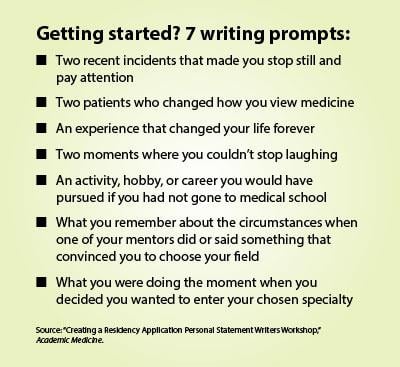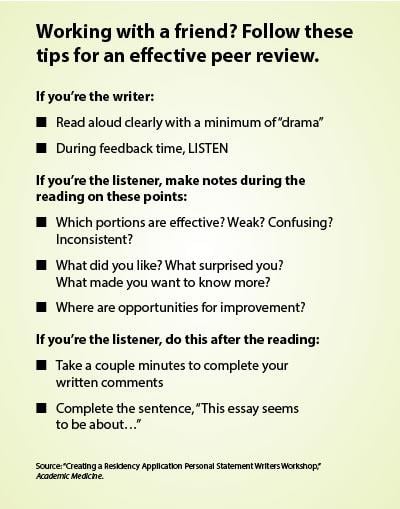Summarizing years of training, your passion for medicine or why you’re choosing a particular specialty in one eloquent personal statement can feel daunting. That’s why professors designed a special workshop to teach medical students how to beat “writer’s block” and craft effective essays for their residency applications. Follow these steps to begin writing your personal statement.
Professors at the Medical College of Wisconsin offered 109 fourth-year students a two-hour writing workshop and found that certain tools—such as writing prompts and peer critiques—helped students overcome anxiety about reflective writing, generate original essay topics and begin writing effective first drafts, according to a recent study in Academic Medicine.
In fact, 94 percent of students who completed a post-workshop questionnaire reported that “the workshop had been effective in getting their essay launched” and that “the writing generated at the workshop was included in their final essay,” study authors wrote.
Whether you have access to a formal workshop setting, you’re pulling together several of your peers to discuss ideas or you’re writing alone, try these recommendations to put your personal statement on the path to success:
Start with writing prompts
A quick question or statement can serve as a catalyst for brainstorming effective essay topics. These writing prompts can stimulate creativity and break down “writer’s block” so you can freely express yourself on the page, study authors noted.
During the workshop, facilitators guided students “through the process of selecting their own personalized writing prompts by reading a list of specific incidents or examples of personal experiences and asking the participants to jot down a word to two about each. Students then picked one or two experiences they found compelling to use as subjects for speedwriting,” according to the study.
The prompts were designed to help students recall pivotal moments or personal interests that may have impacted their desire to pursue a career in medicine. For instance, one writing prompt asked students to recall “what you were doing the moment you decided to enter your chosen specialty.” Other prompts referenced more personal, reflective topics, such as “two moments where you couldn’t stop laughing” or hobbies students may have outside of medicine (see right for additional writing prompts).
Speedwrite, and don’t worry about perfection
Once students jotted responses to at least two writing prompts, they were instructed to elaborate on their responses by “speedwriting,” which entails “writing continuously and without editing, focusing on narrative, story and action,” according to the study.
Students were encouraged to write without stopping for 20 minutes, and if they struggled to think of words during the allotted time, instructors advised them to simply write, “I can’t think of anything” until additional phrases came to mind. “Just keep going!” was the mantra of the speedwriting session, study authors noted.
“I liked the free writing,” one student from the workshop wrote in a questionnaire comment. “It is not something I would have ever done on my own, but [it] surprised me in how much it helped just getting thoughts on paper.”
Edit for clarity
After speedwriting, students reworked what they had written using “cross-outs, arrows to indicate reordering and basic editing.” When they finished editing their speedwriting responses, students submitted them to instructors, who photocopied and distributed the responses to workshop participants for peer critique. Students in each workshop group received a stack of photocopied essays from their peers to review.
Request a peer-critique and read your work aloud
Peer critiques followed a simple set of rules: Each “student writer” had to read his or her essay aloud while “listeners followed along, marking their copies where their interest was piqued or where they found wording unclear,” according to the study.
Listeners were given additional time to write comments on each students’ essay, including a summary of the main topic they believe the essay addressed. Afterward, they discussed these comments with student writers who had to sit quietly and listen as their peers offered written feedback, observations and suggestions.
Student writers could attentively listen and take notes based on peer comments, but they were not allowed to verbalize or defend their thoughts during peer critiques. This allowed students to focus on ways to improve their essays instead of using peer evaluation to defend their writing.
Of all the writing activities, study authors noted that reading speedwriting responses aloud was “the most intimidating aspect of the workshop” for students. Yet the majority of students also reported that receiving peer feedback was “the most helpful task” in the workshop.
Analyze mistakes for revision
After peer critiques, instructors allowed time for personal reflection and analysis. Students discussed what they discovered while listening to comments and writing insights from their peers. This allowed them to assess the effectiveness of the critique and note major lessons to implement in future personal statement revisions, according to the study.
Want more writing and residency application tips? Check out these resources
- Learn how to write a competitive CV using these six strategic steps.
- Find out how many residency programs students really apply to each year (broken down by specialty).
- Read how to get published, and review this list of the top journals seeking to publish work from physicians in training.
- If you’re just still in the early years of your training but are getting a head start preparing for residency, also be sure to consult this must-have checklist of tasks to prioritize during your first and second years of training. Also, save this second checklist for success during your third year of med school.





